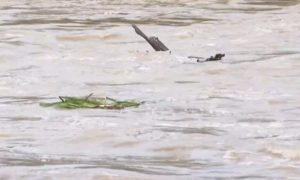SYDNEY: In a fascinating revelation, scientists have unveiled a new chapter in Australia’s prehistoric past, shedding light on an amphibian species that roamed the continent approximately 247 million years ago.
The discovery finally puts to rest a mystery that has intrigued researchers since the 1990s when the fossilized remains of this enigmatic creature were stumbled upon by a retired chicken farmer in New South Wales.
Less than a handful of fossils belonging to this lizard-like species have been identified across the globe, making this finding a rare gem in the field of palaeontology. The implications of this discovery are profound, potentially altering our understanding of amphibian evolution in Australia.
The incredible journey of uncovering this species began in an unsuspecting place: a broken garden wall at Mihail Mihaildis’s home in Umina, a location roughly 90 minutes north of Sydney. Nearly three decades ago, Mihaildis acquired a hefty sandstone slab, weighing 1.6 tonnes, with the intention of repairing the wall. As he meticulously chiselled through the stone’s layers, an astonishing sight emerged – the preserved silhouette of an entirely unfamiliar creature.
Recognizing the magnitude of his find, Mihaildis reached out to the Australian Museum in Sydney to share his discovery, eventually handing over the fossil in 1997. It was within the museum’s climate-controlled display room that a young Lachlan Hart, destined to become a palaeontologist, first encountered the fossil.
Hart’s journey came full circle when, 25 years later, the very same fossil became a cornerstone of his PhD research, a twist of fate he describes as “insane.” The decision to entrust Hart’s team with this treasure was, in his words, “dumb luck,” as their ongoing exploration focused on the life that thrived in Australia during the Triassic era, around 250 million years ago.
What sets this discovery apart is the remarkable preservation of a “nearly complete skeleton,” an exceptional rarity in the world of palaeontology. The fossil has retained not just the head and body, but also the fossilized impressions of the creature’s skin and even fatty tissues, an ensemble that provides invaluable insights into the animal’s anatomy and ecology.
Through meticulous analysis, Hart and his colleagues have estimated that this amphibian measured around 1.5 meters in length, boasting a salamander-like physique. Dubbed Arenaepeton supinatus, the species name translates to “sand creeper on its back” in Latin, alluding to its peculiar fossilized posture.
Tracing the amphibian’s history, scientists deduce that it once inhabited the freshwater lakes and streams of Sydney. Belonging to the Temnospondyli family, a group of hardy amphibians that survived two of Earth’s mass extinction events, this species existed through the trials of history, including volcanic eruptions that wiped out a significant portion of the planet’s inhabitants some 250 million years ago.
Remarkably, only three other fossils belonging to the Temnospondyli family have been positively identified in Australia. The findings, published recently, illuminate Australia as a haven for diverse life forms during times of mass extinction, providing refuge for creatures seeking to adapt and endure.
The extraordinary fossil, now a symbol of the past’s resilience and the present’s curiosity, is slated to take its place on permanent display at the Australian Museum later this year. As it beckons visitors to contemplate the aeons that have passed, this discovery serves as a testament to the power of preservation, inquiry, and the unending stories hidden beneath the Earth’s surface.
























